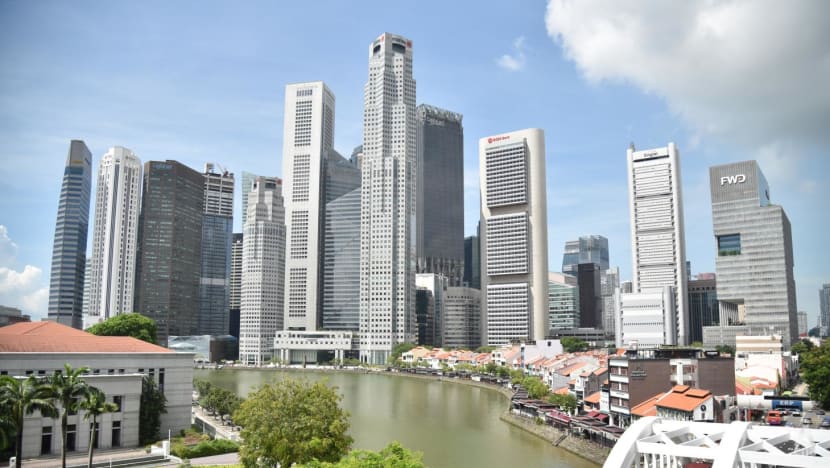Singapore's economy grew 4.3% in the second quarter of 2025: MTI advance estimates
MTI says "significant uncertainty and downside risks" remain in the global economy in the second half of the year, given the lack of clarity over US tariffs.

Skyline of the central business district in Singapore. (Photo: CNA/Syamil Sapari)

This audio is generated by an AI tool.
SINGAPORE: Singapore's economy grew 4.3 per cent in the second quarter of 2025, faster than the 4.1 per cent growth in the first quarter of the year, according to advance estimates from the Ministry of Trade and Industry (MTI) on Monday (Jul 14).
But the ministry flagged "significant uncertainty and downside risks" remain in the global economy in the second half of the year, given the "lack of clarity" over the United States' tariff policies.
In April, MTI lowered Singapore's gross domestic product (GDP) growth forecast for 2025 to 0 per cent to 2 per cent, pointing to the effect of US President Donald Trump's tariffs. The ministry previously had a forecast of 1 per cent to 3 per cent growth for the year.
Last week, the Trump administration started sending out letters on tariffs to several countries. The higher tariffs will kick in from Aug 1, and affects Singapore's neighbours such as Malaysia and Indonesia.
Singapore's economic task force, which was set up to help businesses and workers navigate the impact of the US tariffs, announced that it would launch grants for companies by October this year. The 10 per cent baseline tariffs on goods from all countries, including Singapore, took effect in April.
Advance gross domestic product estimates are mainly computed from data gathered in the first two months of the quarter. They are intended as an early indicator for the three-month period, and may be revised when more data is available.
On a quarter-on-quarter seasonally adjusted basis, Singapore's GDP expanded by 1.4 per cent in the second quarter, compared with a 0.5 per cent contraction in the first three months of the year.
WEAKER SECOND HALF
After a strong performance in the first half of the year with GDP growth averaging 4.2 per cent year-on-year, analysts were cautious about the rest of the year because of the uncertainty of US tariffs.
"External headwinds are expected to exert significant pressure soon," economist Sheana Yue from Oxford Economics wrote in a note on Monday, adding that the "biggest challenge" will come from US trade policy.
"A particular challenge may arise from the focus on transshipment – Singapore's re-exporting sector accounts for roughly two-thirds of all trade," she said.
Ms Yue also noted that sectors linked to exporting activities made gains in the second quarter, and that strength is unlikely to be sustained as external conditions darken.
The frontloading of goods exports during the 90-day pause in US reciprocal tariffs led to a notable pick-up in trade-related expansion, said DBS senior economist Chua Han Teng.
External demand and economic growth will face downside pressures due to global tariffs and weak business sentiment, he wrote in a note.
The bank is keeping its GDP growth forecast for 2025 at 2 per cent, which implies "much weaker growth" in the second half of the year.
"We expect trade-related sectors ... to bear the brunt of the weakness," he added.
Modern services sectors could also face negative effects from an uncertain business landscape, said Mr Chua.
"For example, in the financial services sector, business credit demand and intermediation would be dampened, as firms adopt a wait-and-see approach, amid a tougher operating landscape and lingering uncertainties," he added.
OCBC chief economist Selena Ling said full-year growth should be slightly above 2 per cent, given the healthy performance of the first half of the year and the uncertainties that could cause a "sharp moderation" in growth momentum in the second half.
It is key to monitor the potential sectoral tariffs on semiconductors and pharmaceuticals, she said, noting their contributions to industrial output and non-oil domestic exports.
SECTORS
The manufacturing sector reported growth of 5.5 per cent in the second quarter compared with a year ago, up from 4.4 per cent in the previous quarter.
"Growth was driven by output expansions across all clusters, except for the chemicals and general manufacturing clusters," said MTI.
The sector grew by 0.1 per cent on a quarter-on-quarter seasonally adjusted basis, reversing the 5.5 per cent contraction reported in the first quarter.
Growth in the construction sector eased slightly to 4.9 per cent in the second quarter, down from 5.1 per cent in the first quarter.
On a quarter-on-quarter seasonally adjusted basis, the sector grew 4.4 per cent, compared with the 1.8 per cent contraction in the first three months of the year. An increase in public sector construction output supported growth in the second quarter, said MTI.
For the services sectors, the wholesale and retail trade, and transportation and storage sectors grew 4.8 per cent, compared with 4.6 per cent in the first quarter.
The ministry said growth in the transportation and storage sector was mainly driven by the water transport segment, and growth in the wholesale trade sector was led by the machinery, equipment and supplies segment.
"These segments were in turn partly boosted by front-loading activities in the region ahead of the expiration of the 90-day pause in the US’ reciprocal tariffs," said MTI.
The retail trade sector expanded due to higher sales volumes in both the motor vehicle and non-motor vehicle segments.
On a quarter-on-quarter seasonally adjusted basis, growth in the wholesale and retail trade, and transportation and storage sectors increased to 2.7 per cent, from 0.8 per cent in the first quarter.
The group of sectors made up by the information and communications, finance and insurance, and professional services sectors grew 3.8 per cent, slightly higher than the 3.7 per cent growth in the first quarter.
MTI said there was strong demand for IT and digital solutions, while the professional services sector growth was led by the head offices and business representative offices segment.
Growth in the finance and insurance sector was largely driven by banking activities, as well as activities auxiliary to financial activities.
On a quarter-on-quarter seasonally adjusted basis, this group of sectors grew 1.3 per cent, compared with a contraction of 4.4 per cent in the first quarter.
The remaining services sectors – accommodation and food services, real estate, administrative and support services and other services – grew 3.4 per cent in the second quarter, up from 2.3 per cent in the previous quarter.
All sectors within the group posted expansions, and growth in the accommodation sector was supported by the year-on-year increase in international visitor arrivals, said MTI.
The sectors in the group collectively expanded by 0.7 per cent, down from 1.2 per cent in the first quarter.

















